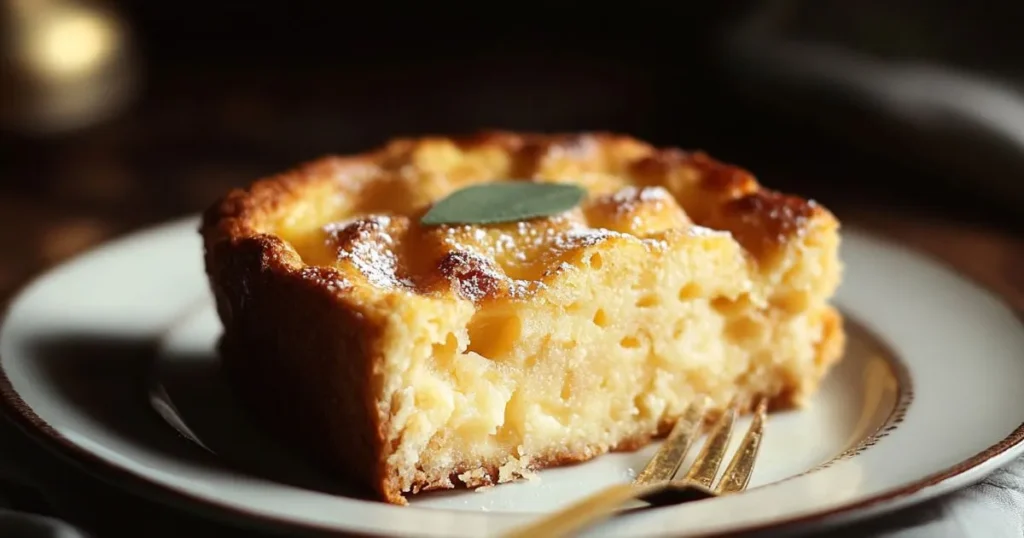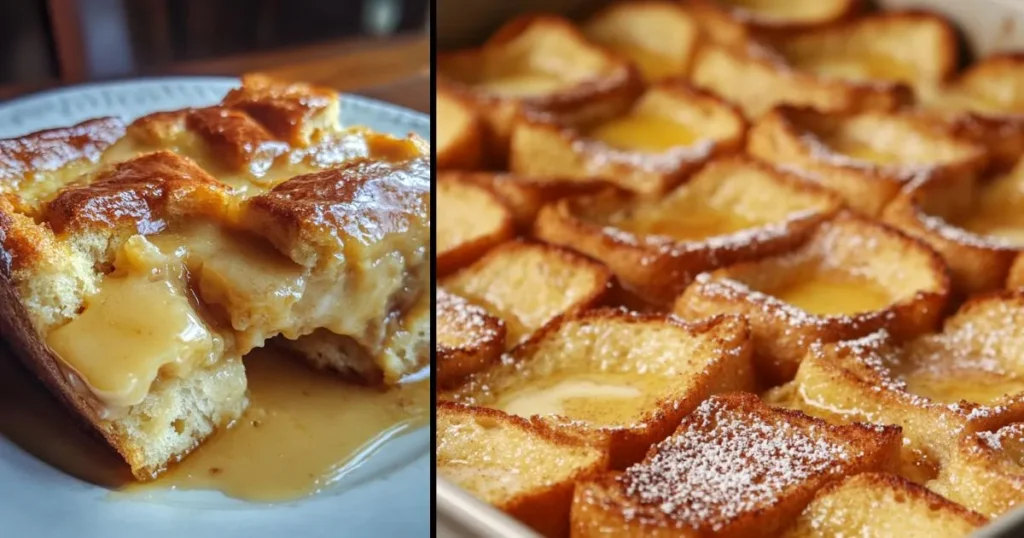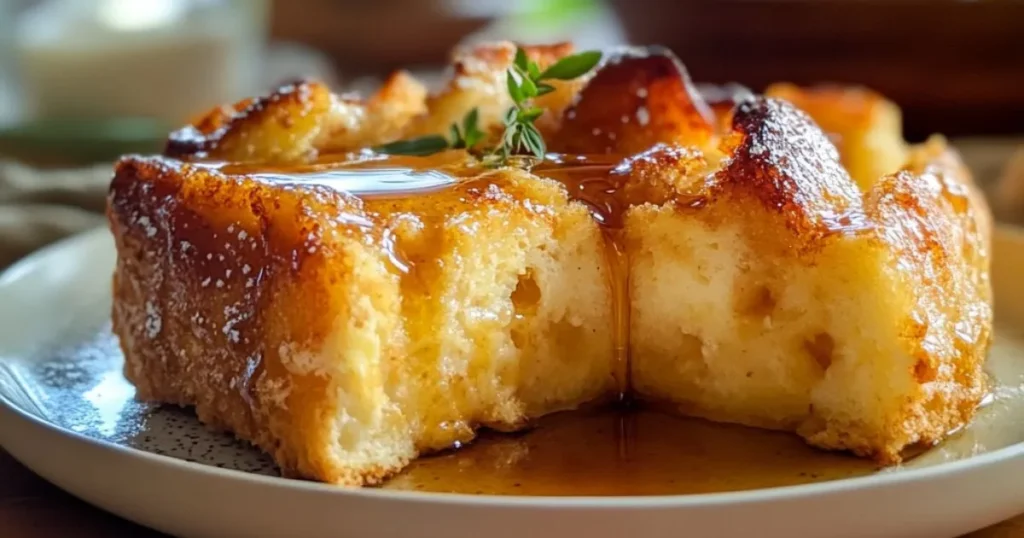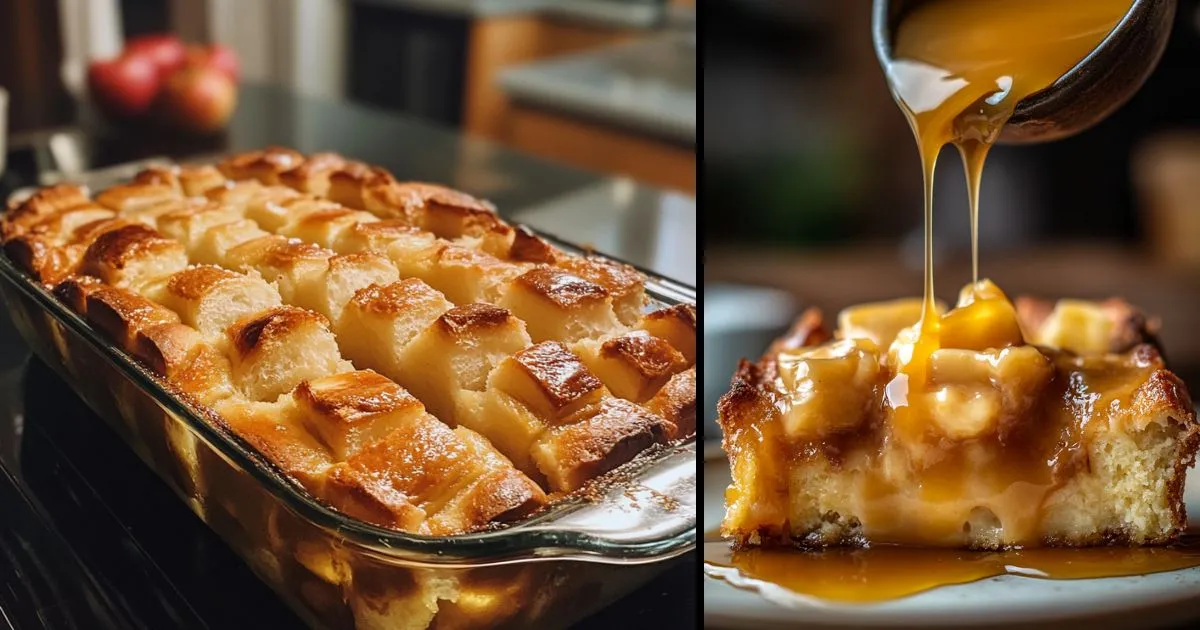The Ultimate Brioche French Toast Casserole
Imagine waking up to the intoxicating aroma of cinnamon, vanilla, and buttery brioche wafting through your home. That’s the promise of this decadent, make-ahead brioche French toast casserole. Perfect for busy mornings or special occasions, this breakfast masterpiece delivers all the flavors of classic French toast with none of the morning rush and hassle of standing over the stove flipping individual slices.
Our foolproof method guarantees a perfect balance of custardy interior and slightly crisp top, making this brioche French toast casserole the ultimate crowd-pleaser for brunches, holidays, or any day you want to make morning special.
Table of Contents
Why This Recipe Works
When it comes to creating the perfect French toast casserole, the details matter. Here’s why this recipe stands head and shoulders above the rest:
- Using Stale Brioche is Key: The rich, buttery nature of brioche bread makes it inherently superior for French toast, and using day-old bread ensures it absorbs the custard perfectly without becoming soggy.
- The Perfect Custard Ratio: We’ve tested dozens of ratios to find the ideal balance of eggs, milk, and cream that creates a silky, flavorful base that infuses every bite of bread with deliciousness.
- Overnight Soak for Maximum Flavor: Allowing the bread to soak overnight means every cube becomes fully saturated with the cinnamon-vanilla custard mixture, resulting in a more complex and delicious flavor profile.
- Strategic Seasoning: A careful blend of warming spices, real vanilla, and just enough sugar creates depth without overwhelming sweetness.
The make-ahead nature of this French toast bake isn’t just convenient—it’s actually essential to developing the best texture and flavor. This recipe transforms a classic breakfast into an effortless morning meal that feels both indulgent and comforting.
Ingredients for Brioche French Toast Casserole
For the Casserole:
- 1 loaf (about 1 pound/450g) day-old brioche bread, cut into 1-inch cubes
- 8 large eggs
- 2 cups whole milk (for richness and proper custard consistency)
- 1 cup heavy cream (provides luxurious texture)
- ¾ cup granulated sugar
- 2 tablespoons pure vanilla extract
- 2 teaspoons ground cinnamon
- ½ teaspoon ground nutmeg
- ¼ teaspoon salt
- 2 tablespoons unsalted butter, melted (for greasing the baking dish)
For the Optional Streusel Topping:
- ½ cup all-purpose flour
- ½ cup brown sugar, packed
- 1 teaspoon ground cinnamon
- ¼ teaspoon salt
- ½ cup cold unsalted butter, cubed
- 1 cup chopped pecans or walnuts (optional)
Note on bread: Day-old or slightly stale brioche is preferable as it absorbs the custard mixture better without becoming overly soggy. If your brioche is fresh, you can cube it and leave it out for a few hours or toast it lightly in a 300°F oven for 10 minutes.

Equipment Needed
- 9×13 inch baking dish (glass or ceramic works best)
- Large mixing bowl
- Medium mixing bowl (for streusel if using)
- Whisk
- Measuring cups and spoons
- Pastry cutter or fork (for streusel)
- Plastic wrap or aluminum foil
- Serrated knife (for cutting brioche)
How to Make Brioche French Toast Casserole
- Prepare the baking dish by generously coating it with melted butter, ensuring all sides and corners are well-greased to prevent sticking.
- Cut the brioche into 1-inch cubes using a serrated knife. Slightly stale bread works best as it will better absorb the custard without falling apart. Spread the cubes evenly in the prepared baking dish.
- Whisk together the custard in a large bowl by combining eggs, whole milk, heavy cream, sugar, vanilla extract, cinnamon, nutmeg, and salt. Whisk vigorously until completely smooth and the eggs are fully incorporated to ensure even flavor distribution.
- Pour the custard mixture slowly and evenly over the brioche cubes, making sure to saturate all pieces. Press down gently on the bread to help absorption.
- Cover the baking dish tightly with plastic wrap or aluminum foil and refrigerate for at least 4 hours, but preferably overnight (8-12 hours). This extended soaking time allows the bread to fully absorb the custard mixture and the flavors to meld together.
- When ready to bake, preheat your oven to 350°F (175°C) and remove the casserole from the refrigerator while the oven heats up (about 20 minutes) to take the chill off.
- If adding the streusel topping, combine flour, brown sugar, cinnamon, and salt in a medium bowl. Cut in the cold butter using a pastry cutter or fork until the mixture resembles coarse crumbs. Stir in chopped nuts if using, then sprinkle evenly over the casserole.
- Bake uncovered for 45-55 minutes, or until the casserole is puffed up, golden brown on top, and set in the center. The internal temperature should reach about 170°F (77°C) when fully cooked.
- Let rest for 10-15 minutes before serving. This resting period allows the casserole to set up slightly and makes serving cleaner and easier.
- Serve warm with your favorite toppings such as maple syrup, fresh berries, powdered sugar, or whipped cream.
Pro Tips for the BEST French Toast Casserole
Perfect Bread Selection and Preparation
While brioche is the gold standard for French toast casserole, its high butter content creates an unmatched richness. The key is ensuring it’s slightly stale. If your bread is fresh, spread the cubes on a baking sheet and dry in a 300°F oven for 10-15 minutes. This removes excess moisture without toasting, creating the ideal foundation to absorb the custard.
Mastering the Soaking Time
The magic of overnight French toast casserole happens during the soak. A minimum of 4 hours works in a pinch, but 8-12 hours delivers superior flavor penetration and texture. You can extend this to 24 hours without issue. The gradual absorption allows the bread to become fully infused while maintaining structural integrity.
Ensuring Even Custard Distribution
For perfect saturation, pour the custard in stages rather than all at once. Add half, let it absorb for 5 minutes, gently press down the bread, then add the remaining custard. For extra insurance against dry spots, use a fork to slightly pierce larger bread chunks, helping the custard penetrate completely.
Temperature Management for Perfect Baking
Remove your casserole from the refrigerator 20-30 minutes before baking to take the chill off. This promotes more even cooking. Bake covered with foil for the first 30 minutes to prevent over-browning, then uncover for the final 15-25 minutes to develop a golden top. For absolute certainty, an internal temperature of 170°F (77°C) indicates the custard is safely cooked while remaining creamy.
Achieving That Coveted Crispy Top
For the ultimate textural contrast, broil the casserole for 1-2 minutes at the end of baking, watching constantly to prevent burning. Alternatively, a streusel topping adds both sweetness and crunch. The butter in the streusel should be very cold to create those desirable crispy crumbles.
Flavor Variations & Add-Ins
Transform your brioche French toast casserole with these delicious variations:
Fruit Additions:
- Fresh Berries: Fold 1½ cups of blueberries, raspberries, or strawberries into the casserole just before refrigerating. For juicier berries, add them on top just before baking.
- Caramelized Banana: Sauté 3 sliced bananas with 2 tablespoons butter and 2 tablespoons brown sugar until golden, then layer between the bread cubes.
- Spiced Apple: Toss 2 cups diced apples with 1 tablespoon cinnamon and 2 tablespoons brown sugar, then sauté for 5-7 minutes until slightly softened before incorporating.
Spice Variations:
- Chai-Spiced: Add ½ teaspoon each of cardamom, ginger, and allspice to the custard.
- Citrus Twist: Add 1 tablespoon orange or lemon zest to the custard and substitute 2 tablespoons of juice for an equal amount of milk.
- Pumpkin Spice: Add ½ cup pumpkin puree and 1½ teaspoons pumpkin pie spice to the custard for a fall favorite.
Creative Toppings:
- Cream Cheese Swirl: Mix 8 oz softened cream cheese with ¼ cup sugar and 1 egg, then dollop and swirl into the casserole before refrigerating.
- Chocolate Lover’s: Sprinkle 1 cup chocolate chips (dark, semi-sweet, or white) between layers of bread cubes.
- Maple-Pecan Praline: Combine ½ cup maple syrup, ½ cup chopped pecans, and ¼ cup butter; warm until combined and drizzle over the casserole during the last 10 minutes of baking.
Adult Version:
For a sophisticated twist, add 3 tablespoons of bourbon, dark rum, or Grand Marnier to the custard mixture. The alcohol will largely cook out, leaving behind a complex flavor that pairs wonderfully with the vanilla and spices.
Make-Ahead, Storage, and Reheating
Make-Ahead Instructions:
This French toast casserole is designed to be prepared ahead of time. For best results:
- Assemble the entire casserole up to 24 hours before baking.
- Cover tightly with plastic wrap or aluminum foil to prevent the bread from absorbing refrigerator odors.
- If using a streusel topping, prepare it separately and store in the refrigerator, then sprinkle it over the casserole just before baking.
Storage Guidelines:
- Refrigerator: Leftover baked casserole can be stored covered in the refrigerator for 3-4 days. Ensure it’s cooled completely before covering to prevent condensation.
- Portion Storage: Consider cutting leftovers into individual portions before refrigerating for quicker reheating and serving.
Freezing Instructions:
- Unbaked: You can freeze the assembled casserole (without streusel) for up to 2 months. Cover tightly with plastic wrap and then aluminum foil to prevent freezer burn. Thaw overnight in the refrigerator before baking as directed, adding about 10-15 minutes to the baking time.
- Baked: Fully baked and cooled casserole can be frozen for up to 2 months. Wrap individual portions or the entire casserole tightly. Thaw overnight in the refrigerator before reheating.

Reheating Methods:
- Oven (Preferred Method): Reheat individual portions at 325°F for 15 minutes or the entire casserole (covered with foil) for 20-30 minutes until warmed through.
- Microwave: While less ideal for texture, you can microwave individual portions on 50% power for 1-2 minutes. The lower power helps prevent the casserole from becoming rubbery.
- Air Fryer: For smaller portions, reheat at 300°F for 3-4 minutes for delightful crispiness around the edges.
Serving Your Brioche French Toast Casserole
Transform your brioche French toast casserole into a memorable breakfast or brunch experience with these serving suggestions:
Sweet Toppings:
- Warm pure maple syrup (the real stuff makes a difference!)
- Fresh berry compote or macerated berries
- Lightly sweetened whipped cream
- Dusting of powdered sugar
- Vanilla bean ice cream (for an indulgent brunch dessert)
- Caramel or dulce de leche sauce
Fresh Accompaniments:
- Mixed fresh berries
- Sliced bananas
- Caramelized apple slices
- Citrus segments (orange, grapefruit, or tangerine)
Savory Sides (for balance):
- Crispy bacon strips
- Breakfast sausage links
- Thick-cut ham slices
- Fresh herb garnish (mint or basil)
Beverage Pairings:
- French press coffee
- Mimosas or Bellinis
- Hot chocolate with whipped cream
- Spiced chai tea
For a complete brunch spread, consider setting up a topping bar with small bowls of various options so everyone can customize their portion. This interactive element makes the meal feel special and accommodates different preferences.

Frequently Asked Questions
Can I use a different bread for this French toast casserole?
While brioche creates the richest, most decadent French toast casserole, you can substitute challah, French bread, or even croissants with good results. The key is using bread with some structure that’s slightly stale. Avoid very soft sandwich bread as it can become too mushy. Remember that brioche’s high butter content contributes significantly to the luxurious texture, so results will vary with different breads.
Why is my casserole soggy in the middle?
Several factors can cause sogginess. First, ensure you’re using day-old or dried bread that can properly absorb the custard. Second, check that your oven temperature is accurate (an oven thermometer helps). Third, the casserole needs sufficient baking time—it should reach an internal temperature of 170°F (77°C). Finally, let it rest 10-15 minutes after baking to set up properly.
Can I make this French toast casserole dairy-free or gluten-free?
Yes, with modifications:
- Dairy-free: Substitute plant-based milk like almond or oat milk for the dairy milk, coconut cream for heavy cream, and vegan butter. The texture will be slightly different but still delicious.
- Gluten-free: Use gluten-free brioche or challah (available at specialty bakeries or frozen in some grocers). Ensure all other ingredients, including vanilla extract, are certified gluten-free.
How do I know when my French toast casserole is cooked through?
A properly cooked French toast casserole will be puffed up with a golden brown top. The center should not be liquidy but should feel set when lightly pressed. For certainty, use an instant-read thermometer; the internal temperature should reach 170°F (77°C). Remember that the casserole will continue setting up slightly as it rests.
Can I halve this recipe for a smaller household?
Absolutely! Use an 8×8 or 9×9 inch baking dish and halve all ingredients. Baking time will need to be reduced to approximately 35-45 minutes, but still check for the same visual cues and internal temperature. This smaller version is perfect for households of 2-4 people.
Can I prepare this without an overnight soak?
While the overnight soak delivers optimal flavor and texture, you can make a quicker version. After assembling, press the bread down into the custard repeatedly and let it soak at room temperature for 30-45 minutes before baking. The result won’t have quite the same depth of flavor, but it will still be delicious for those last-minute brunches.




